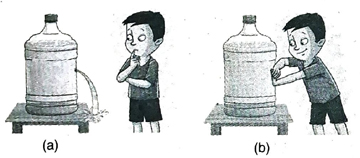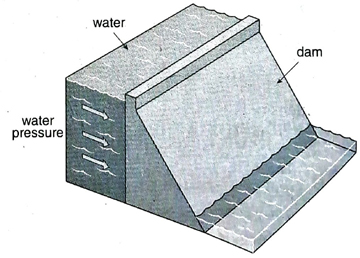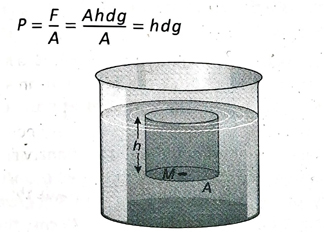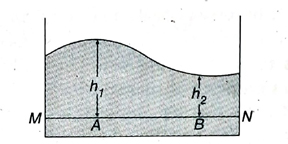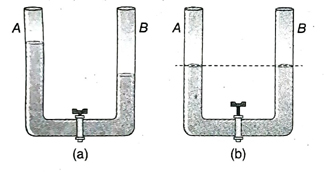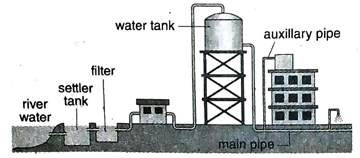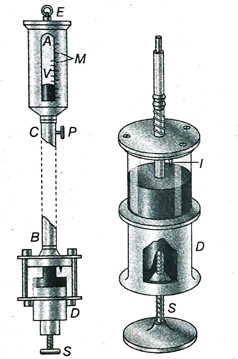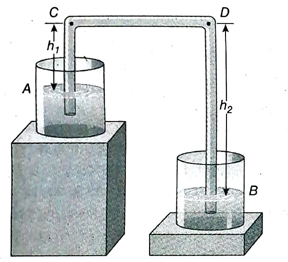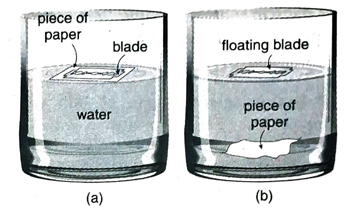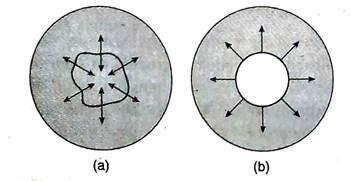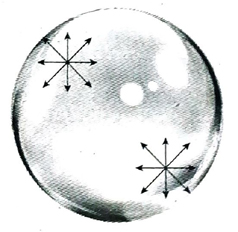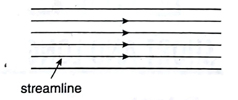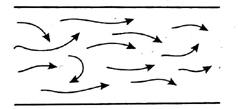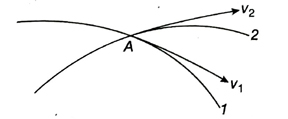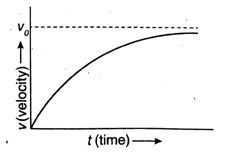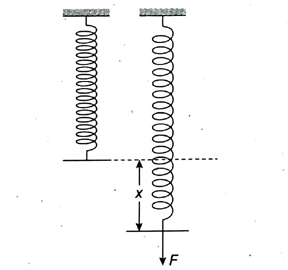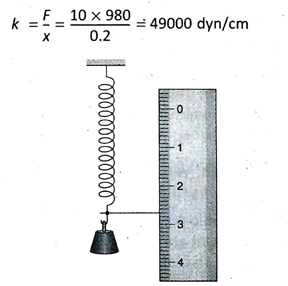WBBSE 9th Class Science Solutions Physical Science & Environment Chapter – 3 Matter : Structure and Properties
West Bengal Board 9th Class Science Solutions Physical Science & Environment Chapter – 3 Matter : Structure and Properties
WBBSE 9th Class Physical Science & Environment Solutions
Synopsis
- Those materials whose molecules move freely past one another (or the materials which flow) are called fluid. Liquids and gases are fluid.
- Pressure of a liquid at a point inside the liquid is defined as the force applied by the liquid in a perpendicular direction on a surface of unit area surrounding that point.
- The force per unit area applied perpendicularly against a surface by the weight of the atmosphere at a point is known as atmospheric pressure.
- Barometer is the instrument by which atmospheric pressure is measured.
- Siphon is an arrangement that carries a liquid from a higher level up and over a barrier and then to a lower level. Here, the flow is maintained by gravity and atmospheric pressure as long as tube in the arrangement remains full.
- Density of a substance is defined as its mass per unit volume.
- Specific gravity of a material is defined as the ratio of its mass to the mass of an equal volume of water at 4°C. It is a dimensionless and unitless quantity.
TOPIC – A
Pressure of Liquids and Air; Archimedes’ Principle
SHORT AND LONG ANSWER TYPE QUESTIONS
1. What is pressure? Write its mathematical expression.
Ans. The force acting normally on unit area of a surface is called pressure.
If a force (F) is applied in a perpendicular direction on an area (A) of a surface, then pressure, P = F/A.
2. What are the units of pressure in CGS system and SI? Establish a relationship between them.
Ans. Units of pressure in CGS system and in Sl are dyn/cm2 and N/m² or pascal (Pa), respectively.
The relationship between them is given by
1 N/m² = 105 dyn / 104 cm² = 10 dyn/cm².
3. What do you mean by a fluid?
Ans. A material which can flow is called a fluid. The molecules of liquid and gaseous materials can move freely past one another. Hence, liquid and gas are called fluids.
4. With the help of a simple experiment, show that liquid exerts pressure.
Ans. A vessel is taken. A hole is made on the surface of the vessel and a cork is used to plug it. The vessel is filled up with water and then the cork is taken out. It is found that water is coming out (gushing out) with great speed [Fig (a)].
Now if the hole is blocked by hand, it is found that water has stopped coming out [Fig 1 (b)]. But to make this happen, one has to use a good amount of force. The reason is that water applies a force on the wall of the vessel and to stop that flow, equal force has to be applied in the opposite direction. The force that water applies on an unit area of the wall in a perpendicular direction is the pressure of water. It can be inferred from this experiment that liquid exerts pressure.
5. What do you mean by pressure and thrust of a liquid? Thrust of a liquid can be categorised as which type of quantity?
Ans. Pressure: Pressure of a liquid at a point inside the liquid is defined as the force applied by the liquid in a perpendicular direction on a surface of unit area surrounding that point.
Thrust: Thrust of a liquid is defined as the force applied by the liquid in a perpendicular direction on a surface adjacent to the liquid. Suppose the liquid exerts a force (F) in a perpendicular direction on an area (A) around a point inside the liquid.
∴ pressure of liquid at that point,
P = F/A or, F = PA
i.e., thrust of liquid = pressure × area.
Thrust is a kind of force. So, thrust is a vector quantity.
6. Write down the characteristics of the pressure of a liquid.
Ans. Characteristics of the pressure of a liquid are as follows:
- Pressure of a liquid at a point inside the liquid depends on the depth and not on the shape of the vessel.
- At any point inside a stationary liquid, a liquid exerts the same amount of pressure in every direction.
- Pressure of a liquid is same at every point on any horizontal plane inside a stationary liquid.
7. Why is bottom of the dam made thicker than the top?
Ans. Water pressure increases with the increase of depth. Hence, the lateral pressure of water is maximum at the bottom. To tolerate such huge pressure, bottom of a dam is made thicker than the top.
8. Establish the mathematical expression for pressure inside a liquid of depth h.
Ans. A vessel contains a liquid of density d. We have to calculate pressure of liquid at a point M at a depth h from the upper surface of the liquid. A circular surface of area A around the point M is imagined. Form each point on the circumference of this circular surface, a perpendicular is drawn on the upper surface. As a result, a right circular cylinder is obtained [Fig ].
Weight of the liquid inside this right circular cylinder of surface area A acts downward in a perpendicular direction.
So the thrust of liquid on this surface,
F = weight of liquid pillar of height h
= Ahdg
∴ pressure of liquid at point M,
9. There is some liquid in a vessel. What is the pressure at a depth h of the liquid when the vessel is lifted up with an acceleration a?
Ans. When the vessel is lifted up with an acceleration α, effective acceleration due to gravity, g1 = g + a
If the density of the liquid is d, then pressure at a depth h of the liquid, P = hdg1 = hd(g + a)
10. There is some liquid in a vessel. What is the pressure at a depth h of the liquid when the vessel is brought down with an acceleration a ?
Ans. When the vessel is brought down with an acceleration a, effective acceleration due to gravity, g₁= g – a
If the density of the liquid is d, then pressure at a depth h of the liquid, P = hdg1 = hd(g – a)
11. With the help of an experiment, ‘show that the free surface of a stationary liquid always remains horizontal.
Ans. Let us assume that the upper surface of a stationary liquid is not horizontal but wavy. A horizontal plane MN is imagined inside the liquid kept in a vessel [Fig.]. Let us suppose that two points A and B are taken on this plane. If density of the liquid is d and depths of points A and B are h₁ and h₂ respectively, then pressure of liquid at point A, P₁= h₁dg and pressure of liquid at point B, P₂ = h₂dg.
Now, as we know that pressure of liquid is same everywhere on a horizontal plane of a stationary liquid, we may write
P₁ = P₂ or, h₁dg = h₂dg
∴ h₁ = h₂
Hence, points A and B are located at the same depth from the free surface of the liquid. Again, points A and B are located on the same horizontal plane. Therefore, our assumption was incorrect and a stationary free surface is horizontal and not wavy.
12. With the help of an experiment, explain the property of a liquid by which it attains same height in several vessels connected simultaneously.
Ans. When a liquid remains in a stationary state in several vessels of different shapes inter-connected with each other, upper surfaces of the liquid remains in the same horizontal level. To explain the above property, we consider a U-shaped tube. In the horizontal portion at the lower end of this U-tube, a stopcock is fitted.. By closing the stopcock, a liquid is poured in the left arm (A) and the right arm (B) of the stopcock so that height of liquid in the arm A is greater than that in the arm B [Fig 5 (a)]. Now if the stopcock is opened, it is seen that the liquid flows from arm A to arm B. This flow continues till the liquid attains the same level in both the arms. [Fig. (b)].
When the stopcock was closed, pressure of the liquid at the bottom surface of arm A was greater than that at the bottom surface of arm B. As a result, when the stopcock is opened, liquid starts flowing from arm A to arm B. When heights of the liquid column in both the arms are equal, pressure of liquid at the bottom surface of both the arms becomes equal and water stops flowing. This proves that stationary liquid surface always prefers to settle at the same level which is an inherent property of a liquid.
13. Write down one practical application of the inherent property of a liquid by which it attains uniform level in several vessels connected simultaneously.
Ans. In many places of a city, the property of a liquid to attain uniform level is utilised for water supply in multi-storied buildings [Fig.]. Filtered water from river or lake or from underground is purified and stored in a huge tank at a height by means of motor pumps. This water is supplied to different buildings through pipes. This water goes up to different heights from the earth’s surface without the help of pumps. Of course, this height is kept lower than the height of the tank so that even at the highest elevation, water can come out from the tap whenever required.
14. What do you mean by atmospheric do you mean by die pressure?
Ans. The force per unit area applied perpendicularly against a surface by the weight of the atmosphere at a point is known as atmospheric pressure.
15. Define standard atmospheric pressure. Calculate the value of standard atmospheric pressure.
Ans. The pressure of a mercury column of 76 cm at a temperature of 0°C at sea level and at 45° latitude is known as the standard atmospheric pressure.
At the sea level and at 45° latitude, if acceleration due to gravity, g = 980.6 cm/s²; density of mercury at 0°C, d = 13.596 g/cm³ and height of mercury column h = 76 cm, then the standard atmospheric pressure is given by
P = hdg = 76 × 13.596 × 986.6
= 1.01325 × 106 dyn/cm²
16. Describe the construction and working principle of a Fortin barometer.
Ans. Construction of Fortin barometer: A glass tube (AB) of uniform diameter and of length 1 meter sealed at one end is filled with mercury and immersed upside down in a vessel (D). The lower portion of the vessel is made up of leather and the upper portion of brass. To protect it from external injury, the entire glass tube is covered with a metal tube (C). To observe the upper surface of mercury, a portion is cut. For measurement of the height of the mercury column, a primary scale (M) and a vernier scale (V) are attached [Fig.].
Working principle: Through the leather coating of vessel D, air may pass freely but not mercury. So pressure at the mercury surface of the vessel is equal to the air pressure. This barometer is hung from a hook (E). By adjusting the screw S, surface of mercury is brought in contact with the ivory pin (/) so that the mercury surface coincides with the zero marking of the primary scale (M). Height of mercury column in the glass tube is measured with the primary scale. Reading of vernier scale is taken by adjusting the screw P. With the help of these two scales, height of mercury column in the tube is calcu A thermometer is kept by the side of the barometer to measure the temperature, at which barometer reading is taken because with the change of temperature, density of mercury and reading of scale also change. So by making necessary corrections in the observed reading, actual reading can be obtained.
17. How can one forecast the weather with the help of a barometer?
Ans. One can forecast the weather from a change of the reading of a barometer.
- If the reading of a barometer decreases slowly, there is a possibility of rainfall. Water vapour is lighter compared to air. If the amount of water vapour increases in air, density of air also decreases at that place. As a result, reading of the barometer comes down slowly.
- If the reading of a barometer drops suddenly, there is a possibility of storm, i.e., low pressure has been created at that place.
- If the reading of a barometer increases slowly, we may conclude that the amount of water pressure in air at that place is decreasing slowly. As a result, weather of that place becomes dry and clear.
- If the reading of a barometer increases suddenly, may be concluded that the amount of water vapour in air at that place has decreased considerably. So, weather of that place remains dry and clear temporarily.
18. What are the advantages of using mercury in a barometer?
Ans. The advantages of using mercury in a barometer are-
- Pure mercury is easily available.
- Mercury do not wet glass, as a result it is easier to take readings.
- Freezing point and boiling point of mercury are -39°C and 357°C, respectively. So, within this long range of temperature, mercury remains in a liquid state.
- Mercury is opaque and bright. So one can take the reading of mercury column easily.
- As the pressure of mercury vapour on the top of the mercury column in a barometer tube is very less, it does not influence the actual reading.
- As mercury is a good conductor of heat, temperature of mercury throughout the tube remains uniform.
- As the density (13.6 g/cm³) of mercury is high, height of the mercury column does not reach so high.
- Volume expansion, density and coefficient of thermal expansion of mercury can be measured accurately. If there is a change of. temperature in the room, it is not difficult to get the original reading after making necessary corrections.
19. Why is a thermometer attached to the mer attached to the barometer tube?
Ans. To know the ter ature at which the reading is taken, a thermometer is placed by the side of the barometer tube. With the change of temperature, density of mercury and reading of scale also change. So, necessary correction of the primary reading gives the actual reading.
20. What is a siphon? Briefly write how it works.
Ans. Siphon is an arrangement that carries a liquid from a higher level up and over a barrier and then to a lower level. Here, the flow is maintained by gravity and atmospheric pressure as long as the tube in the arrangement remains full.
Working principle: Siphon means a U-tube made up of glass, rubber or plastic with unequal arms and open ends. The vessel (A) from which liquid has to be transferred is kept at a higher level and the vessel (B) in which liquid has to be transferred at a lower level. The tube is filled up with the liquid which is to be transferred. Now when the shorter arm of the pipe is placed in the filled-up vessel kept at a higher place and the longer arm of the pipe is placed in the other vessel, then flow of liquid through the tube starts immediately [Fig. ].
21. Write down the conditions of siphon process.
Ans. Conditions of the siphon process are:
- The tube should be filled with the liquid which has to be transferred.
- Level of liquid in the vessel from which liquid has to be transferred is to be kept higher than the level of water in the vessel in which it has to be transferred.
- Due to the atmospheric pressure, liquid goes up the tube in the siphon process. So in order to keep the siphon process continuous, atmospheric pressure has to be maintained.
- There should not be any hole in the tube.
22. Write two applications of siphon.
Ans. Siphon is used in automatic flush system in public toilet. It is also used to transfer liquid from one vessel to another.
23. A drum is being filled up with water through a long pipe attached to a tap. After the drum is filled up, the pipe gets disconnected from the tap for some reason and falls on the ground. If the other end of the pipe remains immersed upto the bottom surface of the drum, what happens? Give a scientific explanation of the phenomenon that takes place.
Ans. Total amount of water of the drum is drained out through the pipe. Raising of water through the pipe, crossing the rim of the drum and then draining out is a phenomenon that may be explained only through the siphon process. In this process, a liquid kept in a vessel may be transferred to a lower level crossing a comparatively higher point through a continuous pipe by the atmospheric pressure. Siphon works without the help of a pump, mainly due to pressure difference inside a stationary liquid.
24. What is buoyancy? Mention is cause.
Ans. The upward thrust exerted by a liquid at rest on a body partially or fully immersed in it is known as buoyant force and the phenomenon is known as buoyancy.
Buoyancy arises from the fact that fluid pressure increases with depth and from the fact that the increased pressure is exerted in all directions so that there is an unbalanced upward force on the bottom of a submerged body.
25. What is Archimedes’ principle?
Ans. Archimedes’ principle or the physical law of buoyancy states that if any body is submerged completely or partially in a fluid at rest, there is a reduction in its apparent weight, whose magnitude is equal to the weight of the fluid displaced by the body.
26. Buoyancy depends on which factors?
Ans. Buoyancy depends on three factors. They are: volume of the immersed portion of the body (v), density of the medium in which the body is immersed (d) and acceleration due gravity at that place (g).
27. What is the direction of buoyancy? When completely immersed, how does buoyancy change with the depth of a body?
Ans. Buoyancy always acts in an upward direction which is the opposite direction of the weight of a body.
When completely immersed, buoyancy does not change with the depth of a body.
28. What is centre of buoyancy?
Ans. Centre of buoyancy is the point where the centre of gravity of the liquid or gas is located before it is displaced by the immersed body. The centre of buoyancy and centre of gravity are same for totally immersed body in a fluid whereas for partial immersion, these two are different.
29. What do you mean by reaction of buoyancy?
Ans. Reaction of buoyancy is the equal and opposite force that the body applies on the liquid or gaseous material when it is partially or fully immersed in a liquid or gaseous material.
VERY SHORT ANSWER TYPE QUESTIONS
Choose the correct answer
1. Dimensional formula of pressure is
A. MLT-2
B. ML-1T-3
C. ML-1T-2
D. ML-2T-²
Ans. C
2. 1 N/m² = how many dyn/cm²?
A. 10
B. 100
C. 0.1
D. 0.01
Ans. A
3. Which of the following does not express a general property of a liquid?
A. elasticity
B. buoyancy
C. surface tension
D. viscosity
Ans. B
4. Which of the following are fluid?
A. solid, liquid and gas
B. solid and liquid
C. liquid and gas
D. solid and gas
Ans. C
5. Buoyant force acting on a body does not depend on the
A. depth of a body completely immersed inside a liquid
B. volume of the immersed portion of the body
C. value of acceleration due to gravity
D. density of displaced liquid
Ans. A
6. If density of a material is 8000 kg/m³, then the value of its specific gravity is
A. 6
B. 16
C. 4
D. 8
Ans. D
7. The weight of a piece of metal is 200 gf in air and when fully immersed in water, it is 150 gf. The specific gravity of the metal is
A. 3
B. 5
C. 6
D. 4
Ans. D
8. A body is completely submerged in a liquid and then released. It starts rising upward. In this condition
A buoyancy = weight of the body
B. buoyancy > weight of the body
C. buoyancy < weight of the body
D. buoyancy changes depending on the depth of the liquid
Ans. B
9. A wooden block is floating on water. In this condition
A. volume of displaced water is equal to the volume of the body
B. mass of displaced water is equal to the mass of the body
C. mass of displaced water is equal to the mass of immersed portion of the body
D. volume of displaced water is equal to the volume of the remaining portion of the body in air
Ans. B
10. In the definition of standard atmospheric pressure, the latitude mentioned is
A. 30°
B. 45°
C. 60°
D. 90°
Ans. B
11. Value of standard atmospheric pressure is
A. 1.013 bar
B. 1 bar
C. 1.1 bar
D. 1.2 bar
Ans. A
12. Weight of different materials of the same volume are different because different materials have different
A. elasticity
B. density
C. Young’s modulus
D. concentration
Ans. B
13. The reading of a barometer taken on the surface of the moon is
A. 76 cm
B. 38 cm
C. 0 cm
D. 19 cm
Ans. C
14. A piece of wood is floating in water in a closed container. If some amount of air is pumped out from the container, then
A. the piece of wood sinks a bit more
B. the piece of wood floats up a bit further
C. volume of the immersed portion of the piece of wood remains unchanged
D. it may float a bit further up at first but later gets completely submerged
Ans. A
15. A piece of wood is floating in water in a closed container. If some amount of air is pumped into the container, then
A. the piece of wood sinks a bit more
B. the piece of wood floats up a bit further
C. volume of the immersed portion of the piece of wood remains unchanged
D. it may sink a bit more at first but floats up later
Ans. B
16. 1 N/m = x dyn/cm, value of x is
A. 1
B. 10
C. 100
D. 1000
Ans. D
Answer in brief
1. What is the relationship between N/m² and Pa?
Ans. 1 N/m² = 1Pa
2. Keeping the force unchanged, if area of the base is reduced, then does the pressure increase or decrease?
Ans. Keeping the force unchanged, if area of the base is reduced, then pressure also increases.
3. Among solid, liquid and gaseous materials, which are fluids?
Ans. Liquid and gaseous materials are fluids.
4. What is the reading of a barometer if it is taken on the surface of the moon?
Ans. As there is no atmosphere on the moon, pressure of air is zero and hence, reading of a barometer becomes zero if it is taken on the surface of the moon.
5. Does a siphon work in an air-free place?
Ans. Siphon does not work in an air-free place because in the siphon process, liquid goes up in the pipe due to the atmospheric pressure. According to modern explanation cohesive force of liquid molecules can causes siphon to work. Therefore presence of atmospheric pressure is not essential.
6. If the density of a liquid is 1.2 g/cm³, what is the specific gravity of that liquid?
Ans. The numerical value of density of any material in CGS system is its specific gravity and hence, in this case, specific gravity and hence of the liquid is 1.2.
7. the dimension of specific What is gravity?
Ans. Specific gravity is a dimensionless physical quantity.
8. What is the dimensional formula of buoyant force?
Ans. Dimensional formula of buoyant force is MLT-2.
9. Specific gravity of a liquid in CGS system is 1.5. What is its specific gravity in SI?
Ans. Value of specific gravity is the same in any type of measurement. So, specific gravity of the liquid in SI is also 1.5.
10. What is the apparent weight of a floating body?
Ans. The apparent weight of a floating body is zero.
11. What is the condition of floatation of a floating body?
Ans. The weight of the floating body must be equal to the weight of the liquid displaced by the body.
12. Does Archimedes’ principle apply to a freely falling body?
Ans. No, Archimedes’ principle is not applicable since weight of a freely falling body is zero.
13. What is the relationship between specific gravity and relative density?
Ans. Relative density is the ratio of the density of a substance to the density of a given substance taken as reference and when the reference substance is pure water at 4°C, then the ratio is called specific gravity.
14. What is a barometer?
Ans. Barometer is an instrument by which atmospheric pressure is measured.
15. What is the value of standard pressure in bar unit?
Ans. Standard pressure = 1.013 bar.
16. There is a mercury barometer inside a lift. If the lift starts moving up with acceleration a (a < g), does the reading of the barometer increase or decrease?
Ans. If the lift goes up with acceleration a (a < g), reading of the barometer decreases.
17. There is a mercury barometer inside a lift. If the lift starts coming down with acceleration a (a < g), does the reading of the barometer increase or decrease?
Ans. If the lift comes down with acceleration a (a < g), reading of the barometer increases.
18. What happens if there is a hole in the siphon?
Ans. If there is a hole in any place of a siphon tube, atmospheric pressure acts on the liquid at that place and as a result, activity of the siphon stops.
19. Give an example where density increases with increase of temperature.
Ans. Density of water increases if temperature increases the range 0°C to 4°C.
20. Where is centre of buoyancy located?
Ans. Centre of buoyancy of a floating body is located at the centre of gravity of the volume of the displaced liquid.
21. When does a body apply buoyant force on another body?
Ans. When a body is partly or fully immersed in a liquid or gaseous material, then that liquid or gaseous material applies buoyant force on the body.
22. Which body applies reaction of buoyancy on another body?
Ans. When a body is partly or fully immersed in a liquid or gaseous material, then that body applies reaction of buoyancy opposite to the buoyancy on the liquid or gaseous material.
Fill in the blanks
1. Pressure of a liquid is constant everywhere in any ………… plane inside a stationary liquid.
Ans. horizontal
2. Specific gravity is the ratio of the mass of a body and the mass of an equal volume of water at ………..
Ans. 4°C
3. In SI, density = ………….. × specific gravity.
Ans. 1000
4. If the depth of a body inside a liquid of uniform density increases, value of the ……….. of liquid on the body also increases.
Ans. pressure
5. A solid material A is fully immersed in a liquid material B. This means density of B is ……….. than the density of A.
Ans. less
6. The weight of a body is …………. to the value of buoyant force when it floats in a partly immersed state in a liquid.
Ans. equal
7 In vacuum, 1 kg of iron is ……….. than 1 kg of cotton.
Ans. lighter
8. The density of material B compared to the density of material A is the ……… of B. –
Ans. relative density
9. Due to the upthrust of a liquid, a body immersed in the liquid suffers an apparent ………. in weight.
Ans. loss
10. The density of silver is 10500 kg⋅m-3 means it relative density is …………
Ans. 10.5
State whether true or false
1. Density is defined as the pressure per unit volume.
Ans. False
2. Barometer is the instrument used to measure atmospheric pressure.
Ans. True
3. The force applied by the liquid tangentially on the surface adjacent to the liquid is known as the thrust of the liquid.
Ans. False
4. Archimedes’ principle is also applicable for a freely falling body or for an artificial satellite.
Ans. False
5. The ratio of mass of a material to the mass of an equal volume of water at 4°C the specific gravity of that material.
Ans. True
6. During construction of a dam, the base of the dam wall is usually made wider.
Ans. True
7. Siphon is used in intermittent flush system.
Ans. True
8. In any unit system the value of relative density have the same value.
Ans. True
9. Pressure of 1 mm of mercury column is 1 torr.
Ans. True
TOPIC – B
Surface Tension
SHORT AND LONG ANSWER TYPE QUESTIONS
1. What do you mean by surface tension? Which natural phenomena gives us ideas about surface tension?
Ans. A tangential force per unit length on a liquid surface that acts perpendicularly with a line imagined on the free surface of a liquid is called surface tension of the liquid. If length of the line = l and force acting on the line = F, then surface tension, S = F/l.
Water droplet, raindrop, soap bubble, air bubble inside water, etc. are spherical in shape due to surface tension.
2. What do you mean by cohesive force and adhesive force?
Ans. Cohesive force: Molecules always attract each other. The force of attraction between like molecules of the same element is called cohesive force.
Adhesive force: The force of attraction between unlike mole-cules of different type is called adhesive force.
3. What do you understand by molecular range?
Ans. Theoretically, cohesive and adhesive forces are supposed to act up to an infinite distance but in reality, it is seen that this force is felt up to a definite distance (r ≈ 10-7 cm) and afterwards, its influence is insignificant. The measure of this distance is called molecular range. So, molecular range is defined as the maximum distance up to which mutual cohesive and adhesive forces between the molecules of a material remains effective.
4. With the help of a simple experiment, how can you prove that surface tension is working on the free surface of a liquid?
Ans. If a needle or a blade is floated in water, it sinks. But if the same needle or blade is kept on a piece of newspaper or on a blotting paper and then floated, it is seen after some time that the paper has became heavier by soaking water. At one point of time, the piece of paper sinks in water but the needle or the blade is found floating on the surface of water.
If a small amount of pressure is given by finger on a tightly held rubber membrane, it is found that the membrane is slightly depressed around the finger. In the same way, water surface is slightly depressed along the side adjacent to the needle or the blade. From this experiment, it is proved that surface tension is working on the free surface of a liquid.
5. Write down the influence of different factors on surface tension.
Ans. Surface tension of a liquid depends on the following factors:
- Temperature: If temperature increases, surface tension of the liquid decreases. At a particular temperature, surface tension of a liquid becomes zero. This is called the critical temperature.
- Pollution: If the water surface is polluted by some material, there is a change of surface tension. For example, surface tension decreases if oil or fat is spread on water.
- Presence of a solute: Surface tension of a liquid changes, if any other material is dissolved in the liquid. For example, surface tension increases if any inorganic substance is dissolved in water and surface tension decreases, if any organic substance is dissolved in water.
- Medium above the surface of liquid: Surface tension depends on the medium present above the free surface of the liquid. At ordinary temperature, if dry air is present above water, surface tension of water is 72 dyn/cm. At the same temperature, if water vapour is present above water, surface tension is reduced to 70 dyn/cm.
6. A circular ring made of thin wire is dipped in soap water and then withdrawn. Now a small water-soaked knot of thread is kept on the ring and finally a hole is made in the knot by means of a needle. Explain what happens.
Ans. Experiment: A ring made of thin wire is dipped into soap water. It is found that a thin film of soap water has been formed in the ring. This is the free surface of the liquid. A small knot made of thread is soaked in soap water and kept on the film formed in the ring. It is seen that the knot is lying on the film in a haphazard way. [Fig. (a)]
Now a pointed pin is taken to pierce the film inside the knot. It is seen that the knot is stretched to take a spherical shape. In this condition also, the film of soap formed in between the ring and the knot of thread remains intact [Fig.(b)].
Conclusion: (1) At first, equal and opposite forces act in the inside and outside of every point of the knot of thread due to surface tension. Therefore, at every point of the thread at that time, total force due to surface tension is zero. For this reason, thread is lying on the film in a haphazard and static manner. (2) Afterwards, when the film inside the knot is pierced, equal forces act in a tangential way to the free surface at every point outside the thread of the knot. Due to this reason, the thread takes a spherical shape.
7. Why is a small water drop or a mercury Idrop spherical in shape?
Ans. Due to cohesive forces between the molecules of a liquid, there is always a tension acting on the free surface of a liquid for which a liquid wants to reduce the free surface of its area. This tendency of contraction of the area of free surface is called surface tension.
Of all the spherical bodies that may be constructed with a given specific volume, a sphere has the minimum area. A small water drop or a mercury drop takes the shape of a sphere only due to surface tension. As a water drop or mercury drop always wants to reduce the area of its free surface, it takes a spherical shape. But as there is some influence of gravity on them, a large sized water drop or mercury drop is slightly distorted.
8. If a painting brush is soaked in water and then taken out, the hairs stick to each other. Why?
Ans. If a painting brush is soake in water, it is found that the hairs stick out from each other [Fig. (a)]. Now if the brush is taken out of water, it is observed that the hairs stick together. Camphor is soluble in water. The place where water mixes with camphor, gets a reduced surface tension. Now the surrounding area of water, having higher surface tension drags the surface having low surface tension towards itself. The camphor also moves along the surface of low surface tension to the surface of high surface tension, where it again gets soluble with water and reduces the surface tension of that region. Thus in this way, a non-uniform force acts on camphor due to this non-uniform surface tension of water, causing the camphor to move in a haphazard manner on water.
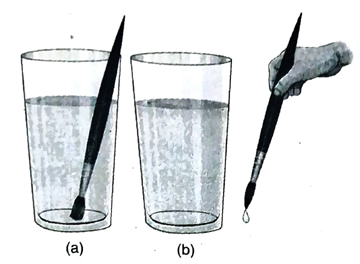
9. If oil is poured on rough sea, it calms down-explain.
Ans. If oil is poured on water, surface tension of water reduces. If some amount of oil is poured on a rough sea, oil spreads in the direction of movement of air. As a result, surface tension of oily water reduces. Pure water having greater surface tension which remains just behind the oily water drags water backward with less surface tension. As a result, waves of lesser heights are produced than before and as a result, the rough sea calms down.
VERY SHORT ANSWER TYPE QUESTIONS
Choose the correct answer
1. At critical temperature, surface tension of a liquid is
A. zero
B. maximum
C. 100 dyn/cm
D. 200 dyn/cm.
Ans. A
2. Dimensional formula of surface tension is
A. MT-2
B. MT-1
C. M-1T-2
D. MLT-2
Ans. A
3. If temperature is increased, surface tension of a liquid
A. increases
B. remains unchanged
C. decreases
D. increases at first, and then decreases
Ans. C
4. If water vapour is present above water instead of dry air, surface tension of water
A. increases
B. decreases
C. remains unchanged
D. increases or decreases depending on the amount of water vapour
Ans. B
5. A blade is floating on water. This phenomenon is mainly due to
A. viscosity
B. gravity
C. buoyancy
D. surface tension
Ans. D
6. If oil is poured on a rough sea, then the sea becomes calm. This is due to
A. viscosity
B. surface tension
C. buoyancy
D. none of these
Ans. B
7. Surface tension is a general property of
A. solids
B. liquids
C. gases
D. all of these
Ans. B
8. The upper surface of mercury is convex due to
A. surface tension
B. viscosity
C. density
D. pressure
Ans. A
9. Which of the following shapes (of equal volume) has minimum surface area?
A. Sphere
B. Cone
C. Cylinder
D. Cuboid
Ans. A
10. When a piece of camphor is put on water, it darts in different direction. This is due to
A. viscosity
B. humidity
C. vapour density
D. surface tension
Ans. D
Answer in brief
1. What do we call the force of attraction between two molecules of the same material?
Ans. Force of attraction between two molecules of the same material is called cohesion.
2. What do we call the force of attraction between two molecules of different materials?
Ans. Force of attraction between two molecules of different materials is called adhesion.
3. What do we call the tendency of the surface area of the free surface of a liquid to contract?
Ans. The tendency of the surface area of the free surface of a liquid to contract is called surface tension.
4. What is the dimensional formula of surface tension?
Ans. Dimensional formula of surface tension is MT-2.
5. With rise of temperature, does the surface tension of a liquid increase or decrease?
Ans. Surface tension decreases with rise of temperature.
6. At what temperature, does the surface tension of a liquid become zero?
Ans. At critical temperature, surface tension of a liquid becomes zero.
7. If some inorganic material is dissolved in water, does the surface tension increase or decrease?
Ans. Surface tension increases if some inorganic material is dissolved in water.
8. If some organic material is dissolved in water, does the surface tension increase or decrease?
Ans. Surface tension decreases if some organic material is dissolved in water.
9. In place of dry air, if water vapour is present over a water surface, then does the surface tension increase or decrease?
Ans. In place of dry air, if water vapour is presen over a water surface, then surface tension decreases.
10. Does surface tension work inside a liquid?
Ans. No, surface tension does not work inside a liquid.
11. What is the power of ‘L’ in the dimensional formula of surface tension?
Ans. Power of ‘L’ in the dimensional formula of surface tension is zero.
Fill in the blanks
1. If inorganic material is dissolved in water, its surface tension ………..
Ans. increases
2. Surface tension becomes zero at ……….. temperature.
Ans. critical
3. Due to ………. equal force acts in every direction along the surface of a liquid at every point.
Ans. surface tension
4. When a laminar flow of liquid takes place over a firmly held horizontal plane, velocity of the liquid layer in contact with the bottom surface becomes ……….
Ans. zero
5. Due to the property of ………… raindrops are spherical in shape.
Ans. surface tension
6. A blade can float on water due to the property of ……….. of water.
Ans. surface tension
7. The tendency of a liquid surface to ……….. its area is called surface tension.
Ans. scalar
State whether true or false
1. At critical temperature, surface tension of a liquid becomes zero.
Ans. True
2. When temperature increases, surface tension of a liquid decreases.
Ans. True
3. Surface tension of liquids is a molecular phenomena.
Ans. True
4. The force applied by the liquid tangentially on the surface adjacent to the liquid is known as surface tension of the liquid.
Ans. False
5. The tendency of the surface area of the free surface of a liquid to expand.
Ans. False
6. Due to surface tension capillary action observed in liquids.
Ans. True
7. Surface tension decreases if some inorganic material is dissolved in water.
Ans. False
TOPIC – C
Viscosity and Bernoulli’s Theorem
SHORT AND LONG ANSWER TYPE QUESTIONS
1. What is viscosity?
Ans. Viscosity is the property of a fluid by which it tries to reduce the relative velocity between two adjacent layers.
2. What is the relationship between viscosity and mobility of a liquid?
Ans. Viscosity is a general property of matter. It is different for different liquids. When viscosity of a fluid increases, mobility decreases.
Example: Honey has greater viscosity than water.
3. Why is viscosity also called internal friction?
Ans. When a body moves or is about to move on another body or on a surface, then the opposing force that works against this motion or tendency of motion is called friction. On the other hand, the property by virtue of which a liquid tries to reduce the relative velocity between two adjacent layers is called viscosity of the liquid. Because of this type of similarity between viscosity and friction, viscosity is also called internal friction of a liquid in many cases.
4. Viscous force depends on which factors?
Ans. Viscous force depends on- (1) nature of the liquid, (2) area of the layers in contact, (3) velocity gradient between the layers.
5. What is meant by an ideal fluid?
Ans. While flowing, a fluid tries to reduce the relative motion between its two adjacent layers due to viscous force. But for an ideal fluid, no such force acts between layers. The ideal fluid is hence nonviscous and streamline.
6. What do you mean by streamline flow or laminar flow?
Ans. If the magnitude and direction of the flow always remains unchanged at any point of the flow line during flow of a fluid, then that flow is called streamline flow or laminar flow. In this condition, there is not any collision amongst the particles of the liquid.
7. What do What do you mean by a st streamline? What is the type of streamline in case of streamline motion of a liquid through a right circular cylindrical tube?
Ans. In case of a streamline motion, the path in which a particle of the fluid flows is called a streamline. In case of a streamline motion, any particle of the fluid always has the velocity of the preceding particle. A tangent drawn at any point of a streamline expresses the direction of the velocity of the fluid at that point.
In case of streamline motion of a liquid through a right circular cylindrical tube, streamlines are parallel to the axis of the tube.
8. What are the characteristics of streamline?
Ans. Characteristics of a streamline are:
- A streamline may be a straight line or a curved line.
- A tangent drawn at any point of a streamline indicates the direction of the velocity of the fluid at that point.
- Two streamlines never intersect with each other.
- Velocity of the fluid increases at that place in the tube where the streamlines are very close to each other and velocity decreases at that place where the streamlines maintain greater distances between them.
9. What do you mean by turbulent flow?
Ans. At any point of a flow line during flow of a fluid, if the magnitude and direction of the flow change in a haphazard way, then the flow is called turbulent flow.
Suppose, a liquid flows through a tube. During this condition, if the liquid particles collide with each other continuously and also move simultaneously, then this type of flow is called turbulent flow [Fig.]. During this time, whirls are created at some places inside the liquid.
10. Why do two streamlines never intersect wo streamlines never intersect each other?
Ans. If a tangent is drawn at any point of a streamline, the tangent indicates the direction of the velocity of fluid at that point.
Now, suppose two streamlines intersect each other at the point A [Fig.]. Two tangents can be drawn at the point of intersection. As a result, two directions of the velocity of the fluid are obtained at the point A, which is not possible. Therefore, two streamlines can never intersect each other.
11. What do you mean by terminal velocity?
Ans. The velocity of a small body which falls through a viscous medium due to gravity increases steadily at the beginning. But as its velocity increases, value of the viscous resistance inside the perpendicular layers of the adjacent fluid of the body also increases. Along with this, buoyancy of the medium acts on the body in an upward direction. As a result, downward acceleration gradually decreases. At a particular point of time, when value of resistance force due to viscosity and buoyancy are equal to the gravitational force, resultant force on the body becomes zero. Then the body falls through the medium with a steady or uniform velocity. This uniform velocity is called terminal velocity.
Thus, terminal velocity is defined as the highest uniform velocity with which a body finally falls through an infinitely spread viscous medium.
12. Draw the velocity-time graph of a body falling through an infinitely spread viscous medium.
Ans. The velocity-time graph of a body falling through an infinitely spread viscous medium is shown here. Here the acceleration of the body decreases gradually. After a certain time the body falls with a constant velocity. This is the terminal velocity, shown in the figure with V0.
13. If you blow between two pages of a book, the pages stick together instead of spreading apart – explain with reason.
Ans. If air is blown between two pages of a book, speed of air increases between them. Hence, according to Bernoulli’s theorem air pressure between the pages becomes less than outside. Due to this difference in pressure, the pages come closer and stick together.
14. If two boats in a river move side by side, they tend to come closer explain with reason.
Ans. If two boats in a river move side by side, the speed of water between the boats becomes more than that of the other sides. According to Bernoulli’s theorem the pressure at the other sides of the boats becomes more than that between them. Therefore the boats tend to come closer.
VERY SHORT ANSWER TYPE QUESTIONS
Choose the correct answer
1. On a plane horizontal surface, some amount of water, shampoo and tar are poured slowly. They move with different speeds and the tar stops at first. This is because, among these three, tar has the minimum
A. viscosity
B. surface tension
C. fluidity
D. elasticity
Ans. A
2. Which of the following quantities is similar to friction?
A. viscosity
B. surface tension
C. buoyancy
D. all of these
Ans. A
3. Which of the following properties is applicable only for a flowing liquid material?
A. elasticity
B. surface tension
C. malleability
D. viscosity
Ans. D
4. Which of the following statements is incorrect?
A. Like friction, viscosity is a force against the motion
B. More the viscosity of a liquid, lesser is its mobility
C. After reaching its terminal velocity, a body starts falling with uniform velocity
D. If the area of a liquid surface decreases, value of viscous force also increases
Ans. D
5. Stir a liquid kept in a vessel and then leave it to itself. After some time the motion subsides because of
A. viscosity
B. surface tension
C. elasticity
D. buoyancy
Ans. A
6. Bernoulli’s theorem is based on the law of
A. conservation of momentum
B. conservation of mass
C. conservation of angular momentum
D. conservation of energy
Ans. D
7. Action of a sprayer depends on
A. Bernoulli’s theorem
B. Jurin’s law
C. Avogadro’s theorem
D. Stoke’s law
Ans. A
8. Bernoulli’s theorem is applicable for
A. viscous fluid
B. non viscous fluid
C. incompressible and non viscous fluid
D. compressible fluid
Ans. C
Answer in brief
1. Bernoulli’s theorem is established on which conservation law?
Ans. Bernoulli’s theorem is established on the law of conservation of energy.
2. If temperature is increased, does the viscosity of a liquid increase or decrease?
Ans. Viscosity of a liquid decreases, if temperature is increased.
3. If temperature is increased, does the viscosity of a gas increase or decrease?
Ans. Viscosity of a gas increases, if temperature is increased.
4. Do two streamlines ever intersect with each other?
Ans. No, two streamlines never intersect with each other.
5. What type of a fluid gives rise to a whirlwind?
Ans. Turbulent flow of a fluid gives rise to a whirlwind.
6. What is the velocity of a liquid layer in contact with the bottom surface when laminar flow of liquid takes place over a firmly fixed horizontal plane?
Ans. Velocity of the liquid layer in contact with the bottom surface is zero.
7. What is that velocity called when a body falls through a viscous medium with maximum uniform velocity?
Ans. That velocity is called terminal velocity.
8. If a body moving with terminal velocity through a viscous medium and density of the body is greater than the density of the medium, then what is the direction of terminal velocity?
Ans. As the density of the body is greater than the density of the medium, direction of terminal velocity is perpendicularly downward.
9. If a body moving with terminal velocity through a long viscous medium and density of the body is less than the density of the medium, then what the direction of terminal velocity?
Ans. As the density of the body is less than the density of the medium, direction of terminal velocity is perpendicularly upward.
10. What is the relationship between viscosity of a liquid and its mobility?
Ans. When viscosity of a liquid increases, its mobility decreases.
11. Bernoulli’s theorem is fully applicable for what type of fluid?
Ans. Bernoulli’s theorem is fully applicable for an ideal fluid.
12. What are the characteristics of an ideal fluid?
Ans. An ideal fluid is incompressible and nonviscous.
13. When a car is running very fast, it is found that light polythene packets etc. keep flying behind the running car. This phenomenon takes place due to which principle?
Ans. This happens due to Bernoulli’s theorem.
Fill in the blanks
1. Water is ……………. viscous than kerosene.
Ans. more
2. …………….. of a fluid is called its internal friction.
Ans. Viscosity
3. When viscosity of a liquid increases, its ………………. decreases.
Ans. mobility
4. When a small ball of iron falls through water, three forces act on it, namely gravitational force, buoyant force and ………… force.
Ans. viscous
5. Ideal fluid has no …………
Ans. viscosity
6. The maximum velocity of a fluid, up to which the flow of the fluid is ………. and beyond which the flow becomes ………. is regarded as the critical velocity for that fluid.
Ans. streamline, turbulent
7. Two …………. never intersect each other.
Ans. streamlines
8. Raindrops fall to the ground with ………….. velocity.
Ans. terminal
State whether true or false
1. Bernoulli’s theorem follows the law of conservation of energy.
Ans. True
2. A smooth, uninterrupted flow in ordered layers, without any energy transfer between the layers is called laminar flow.
Ans. True
3. Mobility of water is greater than that of honey.
Ans. True
4. Two streamlines can intersect each other.
Ans. False
5. Viscosity is called internal friction of a liquid.
Ans. True
6. Viscosity of a fluid decreases with the rise in temperature.
Ans. True
7. For a streamline flow of an fluid the sum of the velocity head, elevation head and pressure head always remain constant at any point in the fluid.
Ans. True
8. If the relative motion between the layers in contact in a flowing liquid decreases, viscosity decreases.
Ans. True
TOPIC – D
Elasticity
SHORT AND LONG ANSWER TYPE QUESTIONS
1. What is elasticity?
Ans. Elasticity is the property of an object or material by which it resists the deformation in its shape or volume or both due to external balanced forces acting on it. The object regains its original shape or volume when these external forces are withdrawn.
2. What is a perfectly elastic body? Also define elastic limit.
Ans. A perfectly elastic body is that body which can regain its original shape, size and volume after the withdrawal of the external forces.
Elastic limit of a body is the upper limit of a deforming force acting on the body, upto which the body behaves as a perfectly elastic body. If the deforming force is increased beyond the elastic limit, the body loses its property of elasticity and get permanently deformed.
3. Define a perfectly rigid body and an inelastic body.
Ans. Perfectly rigid body: A body which has no strain in spite of application of external force of any magnitude is called a perfectly rigid body.
Inelastic body: If a body, deformed by external forces remains in the deformed state even after the withdrawal of these deforming forces, it is called an inelastic body.
4. What is stress? How can it be measured?
Ans. If an elastic body is strained due to the application of external balanced forces, there is an internal reaction force inside the body due to elasticity which resists the external force. When the external force are withdrawn, this internal reaction force helps the body to return to its original state. This reaction force produced per unit area the surface of the body is called stress.
Stress is the reaction of an external applied force on the body. According to Newton’s third law of motion, for every action, there is an equal and opposite reaction.
So, stress is measured by the applied force per unit area on the surface.
5. What do you mean by strain? How can it be measured? Why does it have no unit or dimension?
Ans. Due to application of an external balanced force, there may be a change of form or shape or both of an elastic body. This is called strain.
Measure of strain is the comparative proportional change of initial value of length, shape or volume of an object, i.e.,
As strain is the ratio of two quantities of the same type, it has no unit or dimension.
6. Between rubber and steel, which has greater elasticity? Why?
Ans. Between rubber and steel, steel has comparatively greater elasticity.
This is obvious from the fact that to elongate both of them to the same extent, much more force is to be applied to the steel than rubber. In scientific language, a body is said to be more elastic compared to another body if greater force has to be applied on it to bring about the same amount of strain in it. According to this, elasticity of steel is much more than that of rubber.
7. Ter Units of modulus of elasticity and stress are the same. Explain the authenticity of this statement.
Ans. Modulus of elasticity is the ratio of stress and strain, within the elastic limit. Strain has no unit, so the unit of modulus of elasticity should have the same unit as that of stress.
Units of modulus of elasticity in CGS system and Slare dyn/cm² and N/m² respectively, which are also the units of stress.
8. What do you understand by the force constant of a spring? Which property of a spring is measured by this constant?
Ans. If one side of a spring is firmly fixed to a support and tensile force is applied to the other end, there is an increase in length of the spring. If application of tensile force within elastic limit results in an increase of length x, then F xx or, F = kx.
Here, k is a constant which is called as the force constant of a spring. If x = 1, then F = k. So, necessary tensile force required to increase unit length of a spring is called the force constant of the spring..
One can measure the property of stiffness of a spring by the force constant of the spring.
9. With the help of a simple experiment, discuss how would you measure the force constant of a spring.
Ans. A spring is hung from a firm support. To the other end of the spring, a hook is attached and a mass hanger is hung from there. A parallel indicator is fixed with the hook. A scale is also fixed vertically by the side of the spring so that the end of the indicator touches the scale. Now, without any weight in the hanger, reading of the scale is taken. Suppose the reading is 2.5 cm. Now a 10 g weight is placed in the mass hanger. Due to this weight, the spring is elongated along its length. Suppose, the present reading is 2.7 cm. Applied tensile force, on the spring is F = 10 gf = 10 × 980 dyn and due to this, increase of length is x = (2.7 – 2.5)cm = 0.2 cm
∴ force constant of the spring,
10. It is possible to manufacture thin and fine ornaments with small amount of gold or silver whereas it is not possible to manufacture such thin and fine ornaments with equal amount of iron or copper. Why?
Ans. If the malleability of a material is high, it can be converted into a thin sheet by simple hammering. Gold and silver have greater malleability and ductility as compared to iron or copper. So, though it is possible to manufacture ornaments by iron or copper, it is not possible to manufacture fine and thin ornaments like those of gold and silver.
11. If a vessel of glass or ceramic drops accidentally from hand, it breaks into pieces but if a steel glass falls from the same height, it does not break. Which property of material is expressed through the above incidents?
Ans. If a vessel of glass or ceramic drops from hand accidentally, it breaks into pieces but if a steel glass falls from the same height, it does not break. It is inferred from these two incidents that glass or ceramic is more brittle than steel. It may be mentioned that though a vessel of glass or ceramic breaks down easily, there is not any significant strain of individual parts. That is why glass or ceramic behaves like a perfectly rigid body to a great extent. On the other hand, if a steel vessel falls from a height, it may not break but gets deformed, i.e., permanent strain may appear. That is why steel may be considered as a partially elastic body.
12. To manufacture thin chains, materials like iron, copper, gold, silver etc. are used but lead is never used. Why?
Ans. Ductility of materials like iron, copper, gold, silver are much higher than that of lead. So these can be drawn to form sufficiently thin wires. As the ductility of lead is comparatively low, it is not possible to draw it into thin wire.
VERY SHORT ANSWER TYPE QUESTIONS
Choose the correct answer
1. Which of the following properties is applicable for any type of material?
A. buoyancy
B. surface tension
C. elasticity
D. viscosity
Ans. C
2. As the value of the force constant increases, spring becomes more
A. brittle
B. ductile
C. malleable
D. stiff
Ans. D
3. Dimensional formula of Young’s modulus is equal to which of the following quantities?
A. force
B. momentum
C. stress
D. acceleration
Ans. C
4. If temperature increases, value of Young’s modulus also
A. increases
B. decreases
C. increases at first, then decreases
D. decreases at first, then increases
Ans. B
5. Which of the following statements is incorrect?
A. Young’s modulus is a measure of the property of elasticity for any material
B. Elastic property of a metal changes if some impurity is mixed with the pure metal
C. Elastic limit of steel is much higher than that of rubber
D. Every material is perfectly elastic upto the elastic limit
Ans. A
6. Young’s modulus is the
A. characteristic of solid only
B. characteristic of liquid only
C. characteristic of gas only
D. characteristic of solid, liquid and gas
Ans. A
7. The force constant of a spring is 200 N/m. If the spring is divided into two parts, each part has a force constant of
A. 200 N/m
B. 300 N/m
C. 400 N/m
D. 100 N/m
Ans. C
8. The force constant of a spring is 300 N/m . If the spring is divided into three parts, each part has a force constant of
A. 100 N/m
B. 300 N/m
C. 600 N/m
D. 900 N/m
Ans. D
9. If elastic limit of a material is 10 N, then highest limit the applied force upto which this material behaves like a perfectly elastic material is
A. 5 N
B. 10 N
C. 15 N
D. 20 N
Ans. B
10. Young’s modulus of a perfectly rigid body is
A. 0
B. 1
C. infinite
D. depends on stress
Ans. C
11. The most elastic among the following substance is
A. rubber
B. steel
C. glass
D. copper
Ans. B
Answer in brief
1. How does a body behave up to its elastic limit?
Ans. A body behaves like a perfectly elastic body up to its elastic limit.
2. If there is no strain of a body due to an external balanced force of any magnitude, what do we call the body?
Ans. The body is called a perfectly solid body.
3. In between stress and strain, which one is fundamental?
Ans. In between stress and strain, strain is fundamental.
4. Stress is not fundamental but strain is fundamental. Why?
Ans. If strain is generated, then only stress is evolved. So, in between stress and strain, strain is fundamental.
5. Does liquid and gaseous materials have Young’s modulus?
Ans. Only solid materials have length and as Young’s modulus is a measure of the elastic property of solid materials, so there is no existence of Young’s modulus for liquid and gaseous materials.
6. Is there any change in Young’s modulus with increasing temperature?
Ans. The value of Young’s modulus is reduced if temperature is increased.
7. What is the value of Young’s modulus for a perfectly solid body?
Ans. Value of Young’s modulus for a perfectly solid body is infinite.
8. It is possible to draw a thin wire of iron but it is not possible to do the same for lead due to which property of a material?
Ans. This is due to the property of ductility of a material.
9. Which property of a material is more prevalent in gold than in iron so that it is possible to manufacture fine gold ornaments but not iron ornaments?
Ans. Malleability of gold is more than that of iron.
10. Are the values of Young’s modulus for a thin and a thick iron wire of the same length different?
Ans. No, the values of Young’s modulus of both the values are the same because both are manufactured from the same material.
11. State whether the values of Young’s moduli for thin and thick iron wires of different length will be different.
Ans. Young’s moduli of two iron wires of different length and of different thickness cannot be different because Young’s modulus only depends on the nature of material of the wire.
Fill in the blanks
1. Within the ……….. limit, stress is directly proportional to strain.
Ans. elastic
2. Elasticity of steel is …………. than that of rubber.
Ans. more
3. Coefficient of elasticity is defined as the ratio of the applied ……….. to the change in shape of an elastic body.
Ans. stress
4. The minimum value of stress required to break a wire is called the ………. of that wire.
Ans. breaking stress
5. ……….. is the reaction force that is produced per unit area of cross section of any material due to the application of an external force.
Ans. Stress
6. Brittleness of glass is …………. than that of iron
Ans. more
7. More the …………. of a material, greater is the possibility of converting it to a thinner sheet by hammering.
Ans. malleability
8. k is the force constant of a spring. If the spring is cut into three equal parts, force constant of each part becomes ……….
Ans. 3k
State whether true or false
1. Required tensile force to increase the length of spring by unity is called force constant and its unit in SI is N/m².
Ans. False
2. Within elastic limit, stress is directly proportional to strain.
Ans. True
3. Young’s modulus of a perfectly rigid body is finite.
Ans. False
4. Rubber is more elastic than steel.
Ans. False
5. In the case of an elastic body strain is more fundamental than stress.
Ans. False
6. Required external force to increase the length of a spring by unity is called force constant.
Ans. True
7. Glass is a brittle substance.
Ans. True
8. The elasticity of a material is decreased on hammering it.
Ans. True
9. Strain has no unit.
Ans. True
